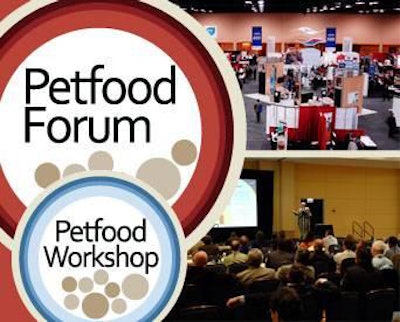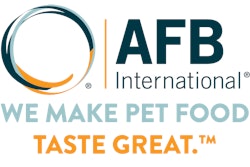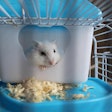
Petfood Forum 2012 and Petfood Workshop: New Product Development will keep you up to speed on all you need to know about the dynamic global petfood industry while you reconnect with longtime colleagues, meet new industry peers and network with leading industry suppliers.
Petfood Forum runs April 2–4 at the Renaissance Schaumburg near Chicago, Illinois, USA, kicking off with opening keynote speaker Betsy Banks Saul, founder and president of Petfinder.com (accompanied by pets from member shelters), and closing with Michael Taylor, deputy commissioner of foods for the US Food and Drug Administration. In between, you’ll enjoy a day and-a-half and three rooms full of industry experts sharing their insights on pet nutrition, petfood packaging, safety, processing and much more. You can also view research posters, meet the researchers and visit the large exhibit hall.
On April 4–5, Petfood Workshop: New Product Development focuses on one of the drivers of our industry’s continued growth—innovation—and how you can improve that process within your company.
Following are the schedule, speakers and topics for Petfood Forum as of press time. For updates, bookmark www.petfoodindustry.com/PFF2012.aspx.
Monday, April 2
12:00-6:30 pm Exhibitor set-up
12:00-7:30 pm Registration/check-in
5:30-7:30 pm Opening reception
Tuesday, April 3
7:30-8:30 am Breakfast
8:30-9:30 am Keynote: Betsy Banks Saul, founder and president of Petfinder.com, discusses how to do well by doing good and shares what she has learned from pets, pet owners and partners like petfood companies during the 15 years her organization has been helping pets find homes.
Banks Saul harnessed the power of the Internet in 1996 with a vision to change the way the public views shelter pets and ensure no pet is euthanized for lack of a good home. Since its inception, Petfinder.com has helped find homes for over 17 million pets. As the largest database of adoptable pets, Petfinder is a unifying force for homeless pets online, making them easier to find (and adopt). Additionally, it allows smaller adoption groups without a physical shelter a way to get the word out about their organizations, thereby expanding the foster community dramatically.
9:30 am-6:30 pm Exhibit hall open
9:30-10:30 am General session: How the brand story impacts e-commerce sales—Jon Roska Jr., founder of PetFoodDirect.com and VP of merchandising for Pet360, shares what he’s learned about pet owners who buy, rate and search for petfood online.
Roska founded PetFoodDirect.com in 1997; his warehouse was a garage, his delivery vehicle a red Chevy Blazer, the leading vendors unwilling to talk with the Internet upstart. Today, the company offers an unparalleled selection of 148+ petfood brands and 16,000+ pet products in all—mailing 60 million pounds of petfood in the last year alone.
10:30-11:00 am Coffee break in exhibit hall/visit with pets from Petfinder.com member shelters
11:00 am-12 pm Time in exhibit hall/visit with shelter pets
12:00-1:30 pm Lunch
1:30-4:55 pm Concurrent sessions—see table and descriptions below
2:55-3:30 Coffee break in exhibit hall
4:55-6:30 pm Reception in exhibit hall
5:45-6:30 pm Poster reception in exhibit hall annex
Wednesday, April 4
7:30-8:30 am Breakfast
8:30 am-12 pm Exhibit hall open
8:30-11:55 am Concurrent sessions—see table and descriptions below
9:55-10:30 am Coffee break in exhibit hall
12-1:15 pm Closing keynote/lunch: Michael Taylor, JD, deputy commissioner for foods for FDA and the person overseeing all food safety policy and regulation for the US, explains how petfood safety fits into the overall food safety picture and what the new Food Safety Modernization Act means for smaller producers.
Taylor is the first person to hold his position, which was created along with a new Office of Foods in August 2009. He received his law degree from the University of Virginia and a BA in political science from Davidson College. Taylor previously served as research professor, School of Public Health and Health Services, George Washington University, and as administrator of the US Department of Agriculture’s Food Safety and Inspection Service and acting under secretary for food safety at USDA. Taylor began his career as a staff attorney at FDA and has also been a senior fellow, Resources for the Future; professor, School of Medicine, University of Maryland; partner, King & Spalding law firm; and VP of public policy, Monsanto Co.
12-10 pm Exhibit hall tear-down
Descriptions and speakers for Petfood Forum concurrent sessions
Nutrition
Yellow pea products: functional petfood ingredients—Gary Lynch, PhD, animal nutttrition senior project coordinator with Roquette, describes the fractioning of yellow peas by wet milling process as a relatively new source of ingredients with applications such as a protein for texturization, a highly digestible source of amino acids, purified pea starch for grain-free formulations and a binder for meat chunks in wet petfood.
Dr. Lynch provides product development support for all Roquette ingredients for petfood and animal feed applications. He has over 22 years’ experience working with manufacturers and consumers in the nutritional management of commercial, pet and exotic animal species. He received his PhD from the University of Illinois in 1987.
The link between nutrition and cancer in companion animals—Elizabeth P. Ryan, PhD, assistant professor with the Animal Cancer Center at Colorado State University, describes the limited but promising research on the role nutrition may play in preventing and controlling canine and feline cancer.
Dr. Ryan holds appointments with the Department of Food Science and Human Nutrition, Colorado School of Public Health and University of Colorado Cancer Center. She conducts nutritional interventions in companion animals with the ultimate goal of providing evidence-based information on bioactive foods for cancer control and prevention. Dr. Ryan’s research is supported by the Flint Animal Cancer Center at CSU, Shipley Foundation, Bill and Melinda Gates Foundation and National Cancer Institute at the National Institutes of Health.
New evidence on the effects of obesity on pet health and the role of manufacturers in pet obesity prevention—Jennifer Adolphe, RD, MSc, PhD candidate at the University of Saskatchewan Western College of Veterinary Medicine, discusses novel research on the negative health effects of obesity in pets, how it can be applied to formulating weight control diets and the role of petfood manufacturers in the treatment and prevention of obesity.
Adolphe has a master’s degree in human nutrition and is a registered dietitian. She is currently completing her PhD in small animal nutrition and cardiovascular health.
QMR: a new technique for determining body composition—Howard Dobson, DVSc, VP of R&D for CanCog Technologies, describes a new technology, quantitative magnetic resonance, that can help determine proportions of fat and lean tissue and total body water in dogs and cats. The technology may also have application for dietary management studies.
Dr. Dobson is a veterinary scientist with a research background in various imaging techniques in dogs and cats. He has 33 research and 55 clinical publications in the scientific literature and has made over 100 research and continuing education presentations to various audiences.
An in vitro procedure for comparing fiber sources in dog foods—Marie Varloud, PhD, scientist with In Vivo NSA, explains a method for studying fiber digestion and fermentation by canine microbiota; this can help in selecting a fiber source for a formulation. Ths in vitro procedure mimics the enzymatic digestion in dogs and allows the production of an adequate quantity of substrate for further fermentation studies.
Dr. Varloud has earned master’s degrees in agricultural techniques and cellular and molecular nutrition, followed by a PhD in animal nutrition (2003-2006). She joined the R&D department of InVivo NSA as a scientist in 2006 and has taught and presented at various congresses.
Particle size effect on feline palatability, processing and more—Kristopher Figge, senior scientist for AFB International, provides details of research that evaluate the potential effects of kibble particle size on feline palatability, production energy usage and texture. The study measured or observed various characteristics and qualities of a standard feline meal before and after extrusion.
Figge is a senior scientist and team leader at AFB International and has been with the company for 12 years. While at AFB, his focus has been on working with customers to improve the palatability of their cat and dog diets. He has presented at several other conferences.
Optimal nutrition for canine athletes—Matt Panasevich, graduate research assistant, University of Illinois Department of Animal Sciences, explains how to formulate performance diets with the goal of providing an ideal ratio of macronutrients to maximize energy usage from both anaerobic and aerobic metabolic pathways; he focuses on research with Greyhounds.
Panasevich is co-advised by Drs. Ryan Dilger and George Fahey at the University of Illinois. He received his bachelor’s degree from Cornell University with a major in animal science and a minor in nutritional sciences. He has been involved with the petfood industry his entire life and aspires to earn his PhD in comparative animal nutrition. Panasevich’s current research is investigating the potential for novel fiber sources to serve as functional ingredients in canine diets.
Innovation in treats and nutritional enrichments for small mammals—Micah Kohles, DVM, director of technical services for Oxbow Animal Health, presents the latest research on nutrition needs and trends for small mammal pets other than cats and dogs.
Dr. Kohles earned his DVM from Kansas State University in 2001 and a master’s degree in public administration from the University of Nebraska-Omaha in 2010. He joined Oxbow Animal Health in 2006. Additional professional responsibilities include his practice at the Nebraska Animal Medical Center in Lincoln, Nebraska, and serving on the board of directors at the Lincoln Children’s Zoo. He is an adjunct assistant professor at the University of Nebraska College of Veterinary Medicine and has worked with multiple zoological institutions.
Marketing/packaging
Trends and insights in pet retail channels—David Lummis, senior pet market analyst for Packaged Facts, provides an update on the US petfood market, with a focus on pet retail channels. Based on recently published reports and featuring Packaged Facts’ exclusive Quarterly Pet Owner Survey data, he examines consumer, marketing, merchandising and macro trends shaping petfood retailing in traditional and alternative retail channels.
Lummis is a regular contributor of articles and market insight to pet industry magazines and major business media. He has written dozens of published reports on pet-related markets including Pet Market Outlook 2012-2013 (March 2012), Pet Retail Channel Trends (January 2012), Pet Medications in the US, 2nd Edition (October 2011), Pet Food in the US (February 2011), and Pet Supplements and Nutraceutical Treats (February 2011).
Going from testimonials to real evidence-based science—Roger Clemens, PhD, president of the Institute of Food Technologists (IFT) and chief scientific officer for ET Horn, stresses the importance of using evidence-based scientific information in making label claims while presenting products to the market and balancing the science with marketing needs and demands.
Dr. Clemens serves as part-time faculty within the University of Southern California Regulatory Science program, where he also enjoys an adjunct appointment as Professor of Pharmacology and Pharmaceutical Sciences within the USC School of Pharmacy. He served as scientific advisor for Nestlé USA for more than 21 years. Dr. Clemens has published more than 50 original manuscripts in nutrition and food science, participated in more than 300 invited domestic and international lectures and served as an expert panel member for the food industry, scientific organizations, trade associations and regulatory agencies in the US, Canada and Europe. He is a spokesperson for IFT and the American Society for Nutrition and a second-term member of the US Pharmacopeia Food Ingredient Expert Committee. Dr. Clemens received a bachelor’s degree in bacteriology, a master’s of public health in nutrition and a doctorate in public health nutrition and biological chemistry from the University of California-Los Angeles.
The importance of petfood smell in leveraging consumer satisfaction—Chloe Champion, markets and trends manager for SPF, and Mark Rubin, senior flavorist for Firmenich, present new research on what pet-owning consumers think about the smell of kibble and its impact on perceived quality and value in today’s marketplace. This research highlights another avenue for product development and brand differentiation by appealing to the primary shopper.
Champion is a specialist in food technology and holds a master’s of science in agronomy as well as a master’s in marketing. She joined SPF in France six years ago as a product manager. Champion is experienced in presenting scientific and marketing topics in a variety of customer forums.
Rubin, based in Geneva, Switzerland, has over 20 years of experience working in the savory flavor industry. His areas of knowledge include process flavours, enzyme modification, top note flavor creation and encapsulation technologies. His current role at Firmenich has principally focused on long-term innovations in petfood aroma through a special partnership with SPF-Diana.
Update on commodity ingredients and commodity risk management—Susan Sutherland, associate director of Agricultural Products for the CME Group, and Bob Bresnahan, CEO of Trilateral, a purchasing and risk management advisor for businesses depending on commodities and related ingredients, will share short- and long-term projections and recommendations for dealing with the commodity market’s volatility.
Sutherland is responsible for grain and oilseed futures and options contracts at the CME Group. In this role. she interacts with commodity importers, commercial firms, traders and industry associations to ensure these contracts meet the needs of the industry. She has more than 20 years of experience in commodity risk management, hedging, market analysis and ingredient procurement. Sutherland holds a bachelor’s degree and master’s degree in agricultural economics, as well as an MBA, all from the University of Illinois.
The founder of Trilateral, Bresnahan has many years of experience in the food manufacturing industry providing specific pricing and hedging recommendations. He spent the first 11 years of his career in the trading pits of the key exchanges in Chicago, Minneapolis and New York before leaving in 1986 to focus on building Trilateral's services in managing purchasing and risk management transactions.
Petfood banks: an emerging industry partner—Elizabeth Asher, executive director, and John Kane, development director, of the Rescue Bank provide information on how petfood companies can use the food bank model to enhance their brands, reverse logistics for rebranded, aging and otherwise nutritious products, communicate nutritional awareness and dispel myths. The Rescue Bank is a nationwide coalition of petfood banks and pantries.
A practicing attorney, Asher previously served as president of the Association of Women Attorneys in Houston, co-founded and served as a director of its Educational Foundation, was chair of the Animal Law Section of the Houston Bar Association, contributed to collaborative law protocols now used in several states and served for more than 12 years as an associate municipal court judge for the city of Houston.
Kane is an experienced project manager, research director, technical writer, presenter and marketing professional. He has prepared and delivered more than 100 presentations for audiences such as military and civilian engineers, investors, volunteers, government regulators, elected and appointed officials and sports enthusiasts.
Consumer goods packaging trends and the importance of effective packaging communications—James Fraser, partner, and Matthew Diamond, managing director, both with Hunter Straker, share consumer behavior insights on what does—and doesn’t—communicate effectively on packaging, as well as examples of trends.
At Hunter Straker, an agency in Canada, Fraser has pioneered a proprietary process called Purchase Design. He writes a monthly Shopper Insights column in Canadian Grocer magazine and is a regular contributor to POPAI and the Path to Purchase Institute.
Diamond has previously worked for Kraft Foods, NHLPA, Targetnet and Capital C. He is a frequently requested international public speaker, author and TV personality. At Hunter Straker, Diamond achieved 40% growth in 2011, his first full year driving a new vision for the agency.
How to arrest the ingredient cost assault on your brand value proposition—Robert Wheatley, CEO of Emergent Communications, offers an antidote to stress on your brand created by pricing challenges. As pricing goes up, the depth, quality and resilience of your brand’s value and traction with core consumers will be tested. This presentation will help you lock into distinctions that separate your business from every other brand on the shelf.
Emergent Communications is a Chicago-based social media, PR 2.0 and brand strategy agency. Wheatley is a pet care category expert and speaks on marketing and brand building topics at pet industry events. He blogs on best practices in petfood marketing.
The good, the bad and the ugly: petfood brands and social media—Bruce Plantz, VP/director of content for Watt Publishing (parent company of Petfood Forum and Petfood Industry), presents exclusive data and insights on how petfood brands and companies are being followed, commented on and highlighted through Twitter and other social media. He will also share best practices in using social media to gain awareness and engagement for your brand.
An admitted early adopter of technology, Plantz launched Watt’s social media sites as well as Facebook and Twitter initiatives early in 2009, after overseeing dramatic changes to workflow, staffing and the final products—both digital and print—produced by the company. Today Watt is in true Web-first XML workflow. Plantz has also consulted with other companies on social media strategy and development. He attended the University of Missouri School of Journalism and has worked in newspapers, magazines and business-to-business media ever since.
Safety/regulatory/processing
Impact of FSMA on regulation of petfood—Daniel G. McChesney, PhD, director of the Office of Surveillance & Compliance, Center for Veterinary Medicine, Food and Drug Administration, provides specifics and timelines for new regulations coming from the Food Safety Modernization Act and what they mean for your company. FSMA has four main themes: prevention; inspection, compliance and response, import safety; and enhanced partnerships.
Dr. McChesney has served in his position since October 2003. Prior to becoming director, he served as deputy director for the Office of Surveillance and Compliance (1999-2003) and as the acting director of the Division of Compliance. He joined CVM as a microbiologist in 1990 and served as the center’s expert on microbial contaminants of animal feed and application of HACCP programs to the feed industry. Dr. McChesney received a BS in biology from Mercer University and his MS and PhD in cell and molecular biology from the Medical College of Georgia.
Validation of Salmonella reduction—Michael Hayes, director of food safety & quality for Del Monte Foods, presents research on validating the reduction of Salmonella in heat-processed, low-moisture foods.
Hayes is responsible for the development, implementation and oversight of quality systems in over 20 Del Monte Factories and 60 co-packers worldwide. He has over 20 years of industry experience in food safety, regulatory compliance and continuous improvement. Hayes earned a degree in food science from the University of Illinois.
Mycotoxins and mycotoxicosis in petfoods—Duarte E. Diaz, PhD, president of A to Zmycotoxins, provides solutions to some of the most common problems with mycotoxins. In plant-sourced raw materials used in petfood ingredients, mycotoxins pose special concerns; they can increase disease incidence and affect intestinal health in animals. Some of the most common problems include sampling and analytical analysis, toxicological responses to different pet species and evaluation of tools for reducing their effects.
Dr. Diaz holds a MS and a PhD in nutrition from North Carolina State University. His research for the past 15 years has focused on mycotoxins; he has given over 50 invited talks on the topic nationally and internationally. In 2005, Dr. Diaz served as the editor for the Mycotoxin Blue Book, which has sold over 5,000 copies and has been translated to Chinese and Russian. Previously he worked as an extension specialist and associate professor for in the US and Europe and with Novus International.
Panel: new safety certification or validation programs—including the National Animal Supplement Council’s Preferred Supplier Partner Program, presented by Bill Bookout, president; Extru-Tech Inc.’s extrusion validation program, presented by Will Henry, director of technology R&D; and American Feed Industry Association’s Pet Food Manufacturing Facility Certification Program and Pet Food Ingredient Facility Certification Program, presented by Leah Wilkinson, director of ingredients and state legislative affairs.
Prior to founding NASC, Bookout spent 15 years in the human medical device and animal health industries. He received a bachelor’s degree in physical sciences at the University of Wyoming and an MBA from Pepperdine University
Henry joined Extru-Tech in 2006 after serving as senior project engineer with Bachelor Controls. He presents extensively on extrusion and food safety around the world. He holds a BS in electrical engineering from Kansas State University.
Wilkinson interacts with state legislatures, the Association of American Feed Control Officials and FDA. She also works with several AFIA committees, including the Pet Food committee. Previously she worked for the National Pork Producers Council, National Cattlemen’s Beef Association and ViaGen Inc.
New nutritional guidelines and labeling codes for petfoods in Europe—Thomas Meyer, secretary general of the European Pet Food Industry Federation (FEDIAF), describes nutritional guidelines and a labeling code recently released by FEDIAF, plus other EU updates.
Meyer studied law in Germany and Great Britain. Prior to joining FEDIAF in 1998, he was deputy secretary general of the European Brewer’s Federation. He has previously worked in the British Parliament as researcher and has practiced law in Germany.
Cross-contamination prevention and controls—James V. Giranda, VP of food safety and quality systems for American Nutrition, explains cross-contamination and how to ensure safe petfood products. The emphasis is on the prevention of microbiological cross-contamination, along with specifics related to GMPs, hygiene, employee practices, environmental controls, Salmonella controls and synergistic control systems.
Giranda’s current responsibilities include developing and implementing food safety, microbiological control and environmental sanitation systems. He also held positions in quality and food safety with International Flavors & Fragrances, the Pillsbury Co., American Sweeteners and Mrs. Paul’s Foods.
Validation of extrusion temperature as a CCP in the petfood process—Galen Rokey, process manager for Wenger Manufacturing, shares results of recent studies indicating the correlation of extrusion temperature and moisture with destruction of pathogenic organisms in an inoculated petfood recipe. Extrusion temperature is identified as a critical control point in HACCP food safety programs, with extrusion moisture and temperature as important variables in the reduction of pathogenic organisms in the petfood process.
After earning a BS from Kansas State University in 1973, Rokey joined Wenger Manufacturing, a major supplier of extrusion and dryer process hardware and technology for the food and feed industries. He brings 39 years of laboratory, extrusion process and research experience to his current position, in which he clients with process issues and provides classroom and hands-on training on the latest extrusion technology. Rokey has authored numerous publications regarding the extrusion process with a focus on petfood production.
Technologies for Salmonella reduction: focus on topical treatment—Carl Knueven, corporate director of R&D for Jones-Hamilton Co., reviews new methods for reducing Salmonella in petfood, including ultraviolet light, irradiation, oxidizing gases and topical treatments, and shares research on using sodium bisulfate topically.
Knueven has worked for Jones-Hamilton Co. in various roles for over 25 years. He holds a master’s degree in chemistry from Bowling Green State University and a bachelor’s in biology from the University of Toledo. He is the inventor of many patents and has presented at numerous conferences.

















